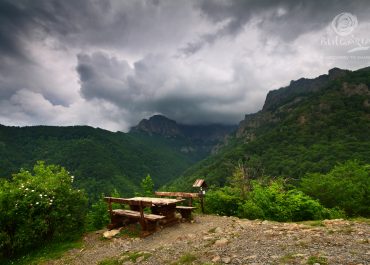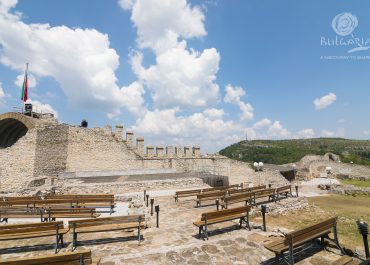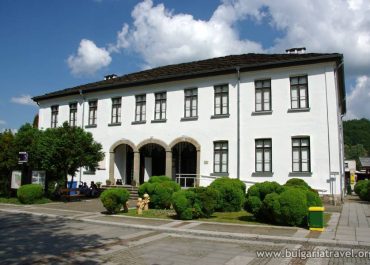
Troyan
The town of Troyan is located in the center of The Stara Planina (The Central Balkan Range), some 160 km northeast of Sofia and 120 km northwest of Plovdiv. The city is situated on the banks of the Cherni Osam River at an elevation of 450 meters above sea level. The Troyan Pass, which facilitates transportation to southern Bulgaria, is 22 km from the town of Troyan. The town has a population of 22,000 people.
Archeological excavations of the Troyan region have revealed that the area was a Thracian settlement as early as the 11th-10th centuries BCE. The Thracians gave the Central Balkan Range its original name – The Hemus Range. The name Troyan comes from the Latin name for the Roman road through the area – Via Trajana. Along this stretch of the Roman road more than 20 fortresses have been discovered.
During the first half of the 19th century, a number of handicrafts experienced rapid growth in Troyan, such as weaving, blacksmithing, and tanning. Pottery workshops also flourished, and the Troyan school of ceramics came to be highly regarded.
One of Troyan’s major attractions is its museum dedicated to folk art and traditional handicrafts. The museum exhibits offer examples of the artisans’ skills, along with their original tools and photographs illustrating techniques employed by ceramicists and metalworkers. Some 7 km from the town of Troyan is the National Collection of Handicraft and Folk Art in the village of Oreshak. The collection’s 9 exposition halls display unique works created by masters from every cultural region in Bulgaria.
Near Oreshak, there a very large monastery, the Troyan Monastery “Assumption of the Virgin.” Of particular interest is The Assumption of the Blessed Virgin Church at the monastery, with murals by Zahary Zograf (1810-1853).
In the village of Cherni Osem, roughly 12 km from Troyan, there is an interesting museum dedicated to natural history. The collection includes almost every animal species found in The Central Balkans. The displays are divided into mammals, reptiles, birds, amphibians, fish, and so forth.
In the Osam River valley near Troyan, on the outskirts of the village Lomets, are remains of the Roman Sostra Fortress. This fortress was the sixth-way station along the Via Trajana that connected the Danube with the White Sea. The fortress was built as an encampment for Roman soldiers. Close to the encampment, there is a settlement, a necropolis, the early Christian basilica “Saint George,” earthenware ovens, and other artifacts. There are no tours of the site, but it may be visited free of charge.
Troyan is the access point to the Central Balkan National Park, where there are many marked hiking trails. Activities in the park include horseback riding and mountain biking, and there are trails particularly well-suited for bird watching. Troyan also offers excellent opportunities for winter sports. Near the Troyan Pass, 22 km southwest of the town, is the small ski center Bekleme. It has three ski runs serviced by two lifts, and is the best place for biathlon and cross-country skiing in Bulgaria.
Bekleme is also a convenient starting point to hike the trails in the Troyan Balkans.
The Troyan region is a preferred destination for those interested in hot springs. The villages of Chiflik and Shipkovo are both plentifully endowed with such springs. The region also offers excellent opportunities for village tourism.
Troyan is well-known for its plum brandy, and every year the town has a festival celebrating this heady beverage.
There are many kinds of accommodation in Troyan and the surrounding area – hotels, villas, and guesthouses – and the region’s dining facilities offer diverse possibilities to sample both the local cuisine and national dishes.
Information and Cultural Center – Troyan
Monday – Friday 8:00 – 18:00
5600 Troyan – center, 103 Str. Rakovski ” Str.
Tel: +359 87 890 1473
Website: https://visit.troyan.bg/0
Facebook: https://www.facebook.com/Infoculturalcentre/?locale2=bg_BG&__nodl&refsrc=deprecated&ref=external%3Awww.google.com
The town of Troyan is located in the center of The Stara Planina (The Central Balkan Range), some 160 km northeast of Sofia and 120 km northwest of Plovdiv. The city is situated on the banks of the Cherni Osam River at an elevation of 450 meters above sea level. The Troyan Pass, which facilitates transportation to southern Bulgaria, is 22 km from the town of Troyan. The town has a population of 22,000 people.
Archeological excavations of the Troyan region have revealed that the area was a Thracian settlement as early as the 11th-10th centuries BCE. The Thracians gave the Central Balkan Range its original name – The Hemus Range. The name Troyan comes from the Latin name for the Roman road through the area – Via Trajana. Along this stretch of the Roman road more than 20 fortresses have been discovered.
During the first half of the 19th century, a number of handicrafts experienced rapid growth in Troyan, such as weaving, blacksmithing, and tanning. Pottery workshops also flourished, and the Troyan school of ceramics came to be highly regarded.
One of Troyan’s major attractions is its museum dedicated to folk art and traditional handicrafts. The museum exhibits offer examples of the artisans’ skills, along with their original tools and photographs illustrating techniques employed by ceramicists and metalworkers. Some 7 km from the town of Troyan is the National Collection of Handicraft and Folk Art in the village of Oreshak. The collection’s 9 exposition halls display unique works created by masters from every cultural region in Bulgaria.
Near Oreshak, there a very large monastery, the Troyan Monastery “Assumption of the Virgin.” Of particular interest is The Assumption of the Blessed Virgin Church at the monastery, with murals by Zahary Zograf (1810-1853).
In the village of Cherni Osem, roughly 12 km from Troyan, there is an interesting museum dedicated to natural history. The collection includes almost every animal species found in The Central Balkans. The displays are divided into mammals, reptiles, birds, amphibians, fish, and so forth.
In the Osam River valley near Troyan, on the outskirts of the village Lomets, are remains of the Roman Sostra Fortress. This fortress was the sixth-way station along the Via Trajana that connected the Danube with the White Sea. The fortress was built as an encampment for Roman soldiers. Close to the encampment, there is a settlement, a necropolis, the early Christian basilica “Saint George,” earthenware ovens, and other artifacts. There are no tours of the site, but it may be visited free of charge.
Troyan is the access point to the Central Balkan National Park, where there are many marked hiking trails. Activities in the park include horseback riding and mountain biking, and there are trails particularly well-suited for bird watching. Troyan also offers excellent opportunities for winter sports. Near the Troyan Pass, 22 km southwest of the town, is the small ski center Bekleme. It has three ski runs serviced by two lifts, and is the best place for biathlon and cross-country skiing in Bulgaria.
Bekleme is also a convenient starting point to hike the trails in the Troyan Balkans.
The Troyan region is a preferred destination for those interested in hot springs. The villages of Chiflik and Shipkovo are both plentifully endowed with such springs. The region also offers excellent opportunities for village tourism.
Troyan is well-known for its plum brandy, and every year the town has a festival celebrating this heady beverage.
There are many kinds of accommodation in Troyan and the surrounding area – hotels, villas, and guesthouses – and the region’s dining facilities offer diverse possibilities to sample both the local cuisine and national dishes.
Information and Cultural Center – Troyan
Monday – Friday 8:00 – 18:00
5600 Troyan – center, 103 Str. Rakovski ” Str.
Tel: +359 87 890 1473
Website: https://visit.troyan.bg/0
Facebook: https://www.facebook.com/Infoculturalcentre/?locale2=bg_BG&__nodl&refsrc=deprecated&ref=external%3Awww.google.com
Virtual map
Photos
© All images, advertising and video materials and/or other information published on this website are property of the Ministry of Tourism and are protected by the Law on Copyright and Related Rights, according to the Bulgarian laws to all applicable international and relevant acts of the European Union.





